TP Link Technologies WN321GV2 54M Wireless USB Adapter User Manual
TP-Link Technologies Co., Ltd. 54M Wireless USB Adapter
User Manual
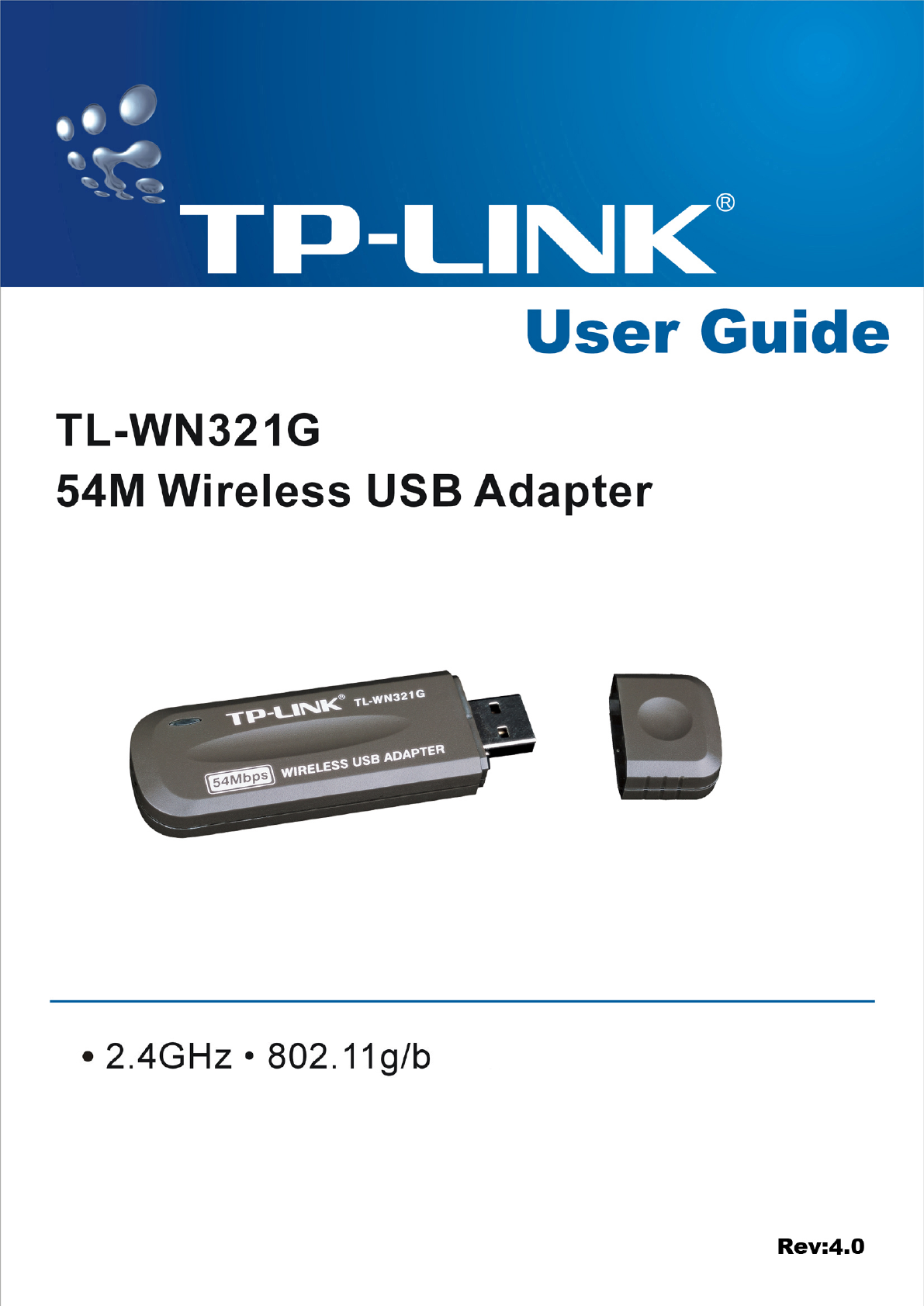

COPYRIGHT & TRADEMARKS
Specifications are subject to change without notice. is a registered
trademark of TP-LINK Technologies Co., Ltd. Other brands and product names are
trademarks or registered trademarks of their respective holders.
No part of the specifications may be reproduced in any form or by any means or used to
make any derivative such as translation, transformation, or adaptation without
permission from TP-LINK Technologies Co., Ltd. Copyright © 2006 TP-LINK
Technologies Co., Ltd. All rights reserved.

FCC STATEMENT
This equipment has been tested and found to comply with the limits for a class B digital
device, pursuant to part 15 of the FCC Rules. These limits are designed to provide
reasonable protection against harmful interference in a residential installation.
This equipment generates, uses and can radiate radio frequency energy and, if not
installed and used in accordance with the instructions, may cause harmful interference to
radio communications. However, there is no guarantee that interference will not occur in a
particular installation. If this equipment does cause harmful interference to radio or
television reception, which can be determined by turning the equipment off and on, the
user is encouraged to try to correct the interference by one or more of the following
measures:
¾ Reorient or relocate the receiving antenna.
¾ Increase the separation between the equipment and receiver.
¾ Connect the equipment into an outlet on a circuit different from that to which the
receiver is connected.
¾ Consult the dealer or an experienced radio/TV technician for help.
This device complies with Part 15 of the FCC Rules. Operation is subject to the following
two conditions:
(1) This device may not cause harmful interference.
(2) This device must accept any interference received, including interference that may
cause undesired operation.
Changes or modifications to this unit not expressly approved by the party responsible for
compliance could void the user's authority to operate the equipment.
FCC RF Radiation Exposure Statement:
This equipment complies with FCC RF radiation exposure limits set forth for an
uncontrolled environment. This device and its antenna must not be co-located or
operating in conjunction with any other antenna or transmitter.
IMPORTANT NOTE:
FCC Radiation Exposure Statement :
This device has been tested for compliance with FCC RF Exposure
(SAR) limits in the typical laptop computer configuration and this device can be
used in substantially similar laptop computers with side mounted PCMCIA slots. This
device cannot be used with handheld PDAs (personal digital assistants) or other portable
host devices. This device and its antenna must not be co-located or operated in
conjunction with any other antenna or transmitter.
CE Declaration of Conformity
For the following equipment: TL-WN321G
Is here with confirmed to comply with the requirements set out in the Council Directive on
the Approximation of the Laws of the Member States relating to Electromagnetic
Compatibility (89/336/EEC), Low-voltage Directive (73/23/EEC) and the Amendment
Directive (93/68/EEC), the procedures given in European Council Directive 99/5/EC and
89/3360EEC.
The equipment was passed. The test was performed according to the following
European standards:
¾ EN 300 328 V.1.4.1 (2003)
¾ EN 301 489-1 V.1.4.1 (2002) / EN 301 489-17 V.1.2.1 (2002)
¾ EN 60950-1: 2001
European standards dictate maximum radiated transmit power of 100mW EIRP and
frequency range 2.400-2.4835GHz; In France, the equipment must be restricted to the
2.4465-2.4835GHz frequency range and must be restricted to indoor use.
Package Contents............................................................................................................. 1
Chapter 1: Introduction...................................................................................................... 2
1.1 Overview of the product..................................................................................... 2
1.2 Features ............................................................................................................ 2
1.3 LED Status ........................................................................................................ 2
Chapter 2: Installation Guide............................................................................................. 3
2.1 Software Installation .......................................................................................... 3
2.1.1 Overview ................................................................................................. 3
2.1.2 Software Installation for Windows 2000................................................... 3
2.2 Hardware Installation......................................................................................... 5
2.3 Uninstall Software.............................................................................................. 6
2.3.1 Uninstall the driver software from your PC .............................................. 6
2.3.2 Uninstall the utility software from your PC............................................... 6
Chapter 3: Configuration................................................................................................... 7
3.1 Profile ................................................................................................................ 7
3.1.1 Add or Edit a Configuration Profile .......................................................... 8
3.2 Link Status....................................................................................................... 10
3.3 Site Survey.......................................................................................................11
3.4 Statistics .......................................................................................................... 12
3.5 Advanced ........................................................................................................ 12
3.6 About............................................................................................................... 13
3.7 An example for application .............................................................................. 13
Appendix A: Specifications.............................................................................................. 15
Appendix B: Glossary...................................................................................................... 16
Appendix C: Contact Information .................................................................................... 18

TL-WN321G 54M Wireless USB Adapter User Guide
Package Contents
The following contents should be found in your box:
¾ One TL-WN321G USB Wireless Adapter
¾ One USB extension cable
¾ Quick Installation Guide
¾ One TL-WN321G Wireless Adapter Resource CD, including:
• Utility and Drivers
• User Guide
• Other Helpful Information
Note: If any of the listed contents is damaged or missing, please contact the retailer from
whom you purchased the TL-WN321G Wireless Adapter for assistance.
- 1 -

TL-WN321G 54M Wireless USB Adapter User Guide
Chapter 1: Introduction
1.1 Overview of the product
The TP-LINK TL-WN321G USB Wireless Adapter gives you the flexibility to install your
PC or notebook PC in the most convenient location available, without the cost of running
the network cables.
Its auto-sensing capability allows high packet transfer up to 54Mbps for maximum
throughput, or dynamic range shifting to lower speeds due to distance or operating
limitations in an environment with a lot of electromagnetic interference. It can also
interoperate with all 11Mbps wireless (802.11b) products. Your wireless communications
are protected by up to 128-bit WEP and WPA encryption, so your data stays secure.
1.2 Features
¾ Complies with IEEE802.11g, IEEE802.11b standards
¾ Supports WPA data security, IEEE802.1x authentication, TKIP/AES encryption,
64/128-bit WEP encryption
¾ Supports 54/48/36/24/18/12/9/6Mbps or 11/5.5/3/2/1Mbps wireless LAN data
transfer rates
¾ Provides USB interface
¾ Supports Ad-Hoc and Infrastructure modes
¾ Supports roaming between access points when configured in Infrastructure mode
¾ Eases configuration and provides monitoring information
¾ Supports Windows 98SE, Me, 2000, XP
¾ Internal Antenna
1.3 LED Status
The LED on the top of this card indicates Link/Act status. It blinks at green light when
sending and receiving data.
- 2 -
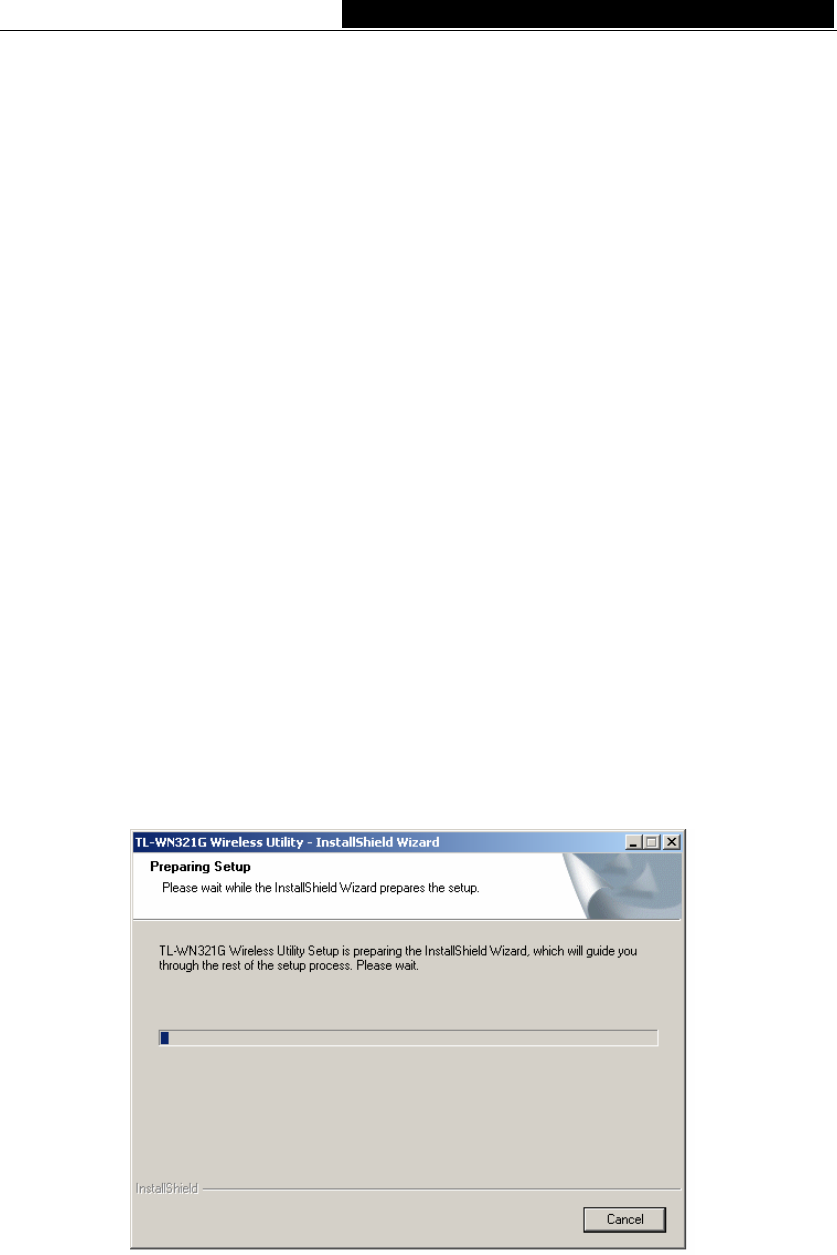
TL-WN321G 54M Wireless USB Adapter User Guide
Chapter 2: Installation Guide
2.1 Software Installation
2.1.1 Overview
The Adapter’s Setup Wizard will guide you through the installation procedure for
Windows 98SE, Me, 2000 and XP. The Setup Wizard will guide you install the Utility and
drivers.
If you install the hardware before the software, you will be prompted “Found New
Hardware Wizard”, click the Cancel button, and run the Setup Wizard program on the
CD-ROM.
The Setup steps for Windows 98SE, Me, 2000 and XP are very similar. The following
setup steps are for windows 2000.
2.1.2 Software Installation for Windows 2000
1. Insert the Resource CD into your CD-ROM drive, click the Start button and choose
Run. In the field that appears, enter F:\XXX\Setup.exe (if “F” is the letter of your
CD-ROM drive; XXX presents the setup program path, which is labeled on the
Resource CD), figure 2-1 should then appear.
2. You can click the Cancel button to end the installation on the Preparing Setup
screen, figure 2-1. Otherwise, the Setup Wizard will display a screen similar to that
shown in figure 2-2 after a moment.
Figure 2-1 Preparing Setup
3. To continue, click the Next button on the screen, figure 2-2. Click the Cancel button
to end the Installation.
- 3 -
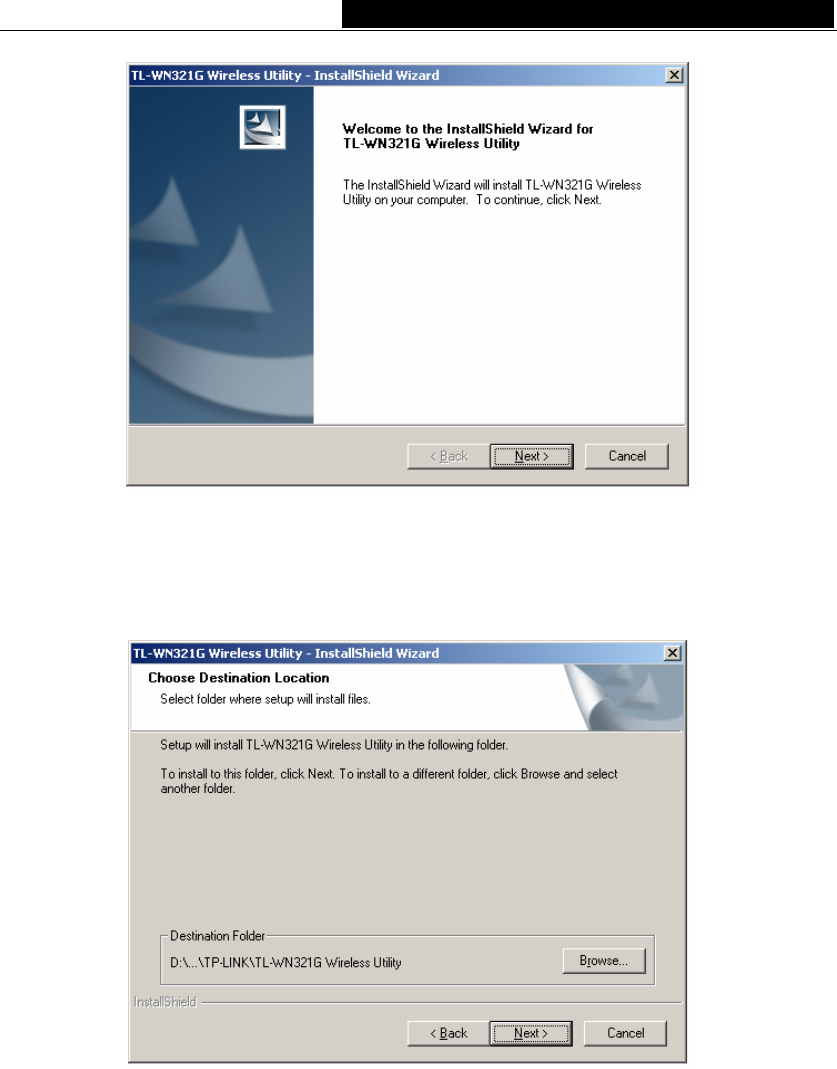
TL-WN321G 54M Wireless USB Adapter User Guide
Figure 2-2 Start Setup
4. Click Browse to change the destination location for the software in figure 2-3. Click
Next to continue the Installation. Click Back to return to the previous page, or click
Cancel to end the Installation.
Figure 2-3 Choose Destination Location
5. While files are copying, you will see a warning box shown in figure 2-4. Please
select YES to continue installation. Our drivers have been tested thoroughly, and are
able to work with the operating system.
- 4 -
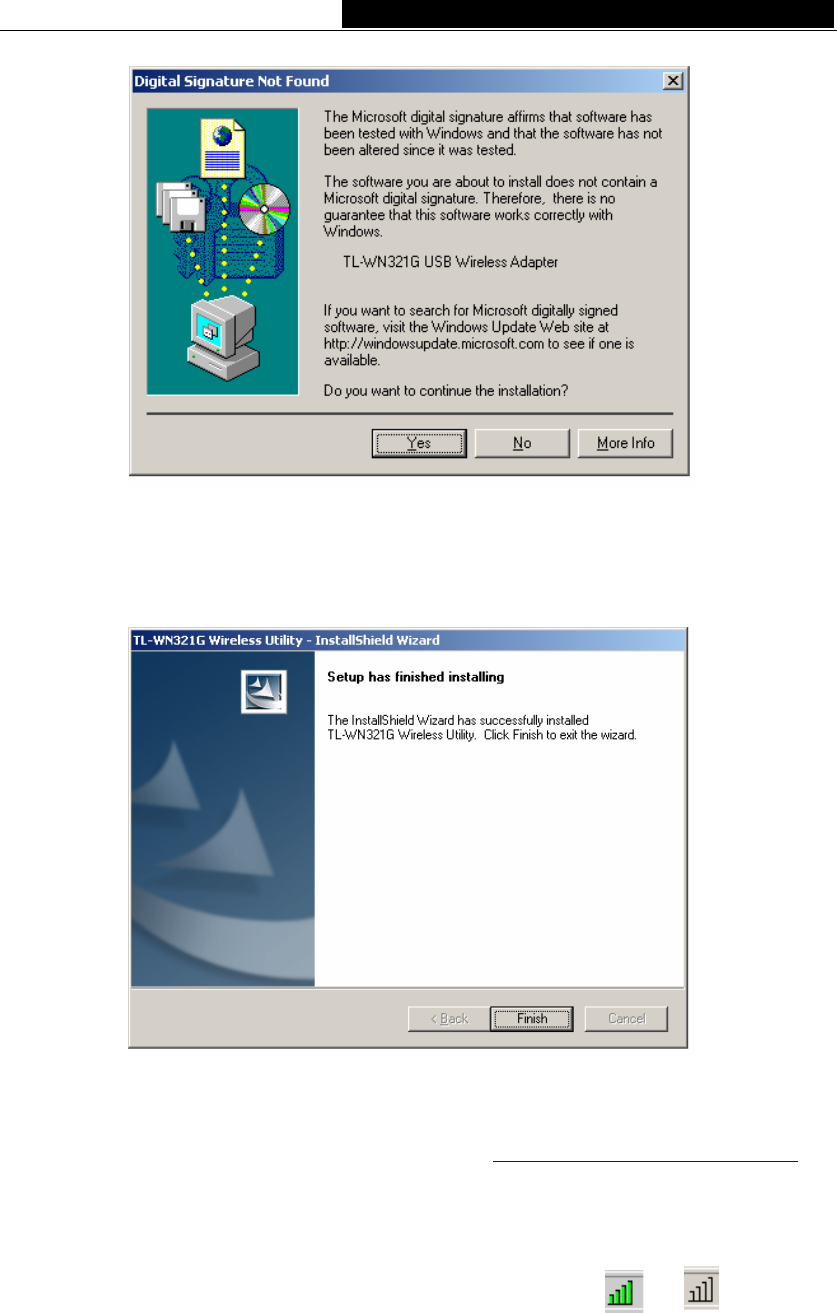
TL-WN321G 54M Wireless USB Adapter User Guide
Figure 2-4 Windows 2000 Warning Box
6. After the files have been successfully copied, the screen in figure 2-5 will appear.
Click the Finish button to finish the wizard.
Figure 2-5 Finish
7. After installing the software, Please plug the adapter into your PC. If you need
instructions as to how to do this, please refer to section 2.2 Hardware Installation. If
you have plugged it into you PC already, please un-plug it and plug it back in. The
OS will automatically detect the adapter and automatically setup the driver for the
adapter. If it does not, please follow the setup steps to finish the driver installation.
After installing the driver successfully, you should see an icon, or , appear in
your system tray.
2.2 Hardware Installation
1. Connect one end of the USB cable to the Adapter.
- 5 -
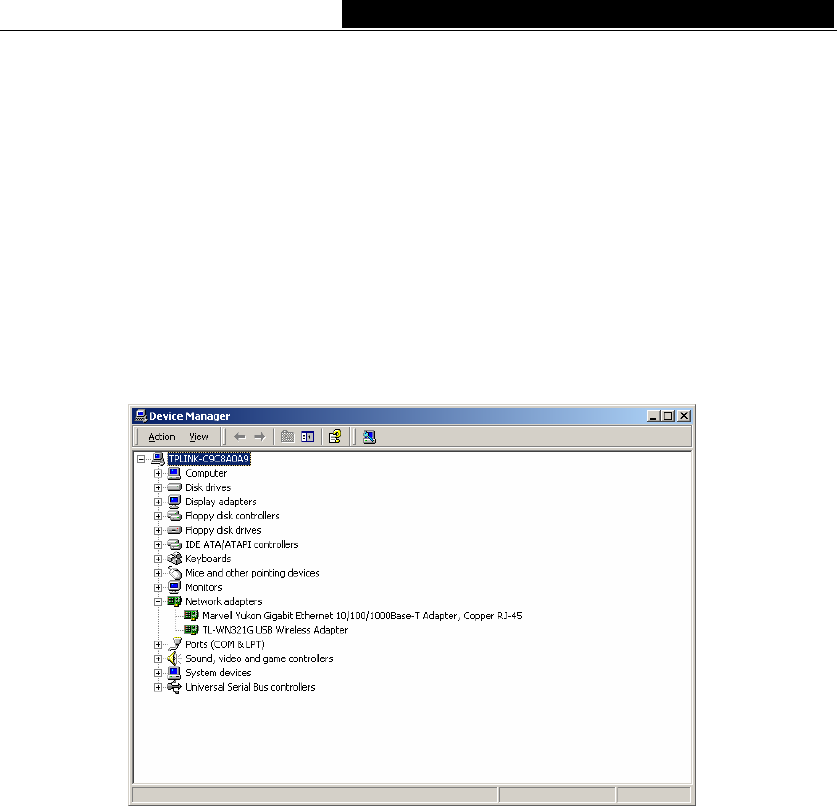
TL-WN321G 54M Wireless USB Adapter User Guide
2. Connect the other end of the USB cable to the USB port on your computer. Because
the Adapter gets its power from the host, there is no external power supply. The LED
should light up when the Adapter is plugged in and the PC is on.
2.3 Uninstall Software
2.3.1 Uninstall the driver software from your PC
1. On the Windows taskbar, click the Start button, point to Settings, and then click
Control Panel.
2. Double-click the System icon, click on the Hardware tab in the System window.
3. Click on the Device Manager button, double-click Network Adapters, and then
right-click TL-WN321G USB Wireless Adapter.
Figure 2-6 Uninstall Driver
4. Click Uninstall..., shown in above figure 2-6, the system will uninstall the driver
software of the adapter from your PC.
2.3.2 Uninstall the utility software from your PC
1. On the Windows taskbar, click the Start button, point to Settings, and then click
Control Panel
2. Double-click the Add/Remove Programs icon, find the TL-WN321G program from
the installed program list, highlight it and click the Remove button.
3. Following the Install Shield Wizard will uninstall the utility software from your PC.
- 6 -
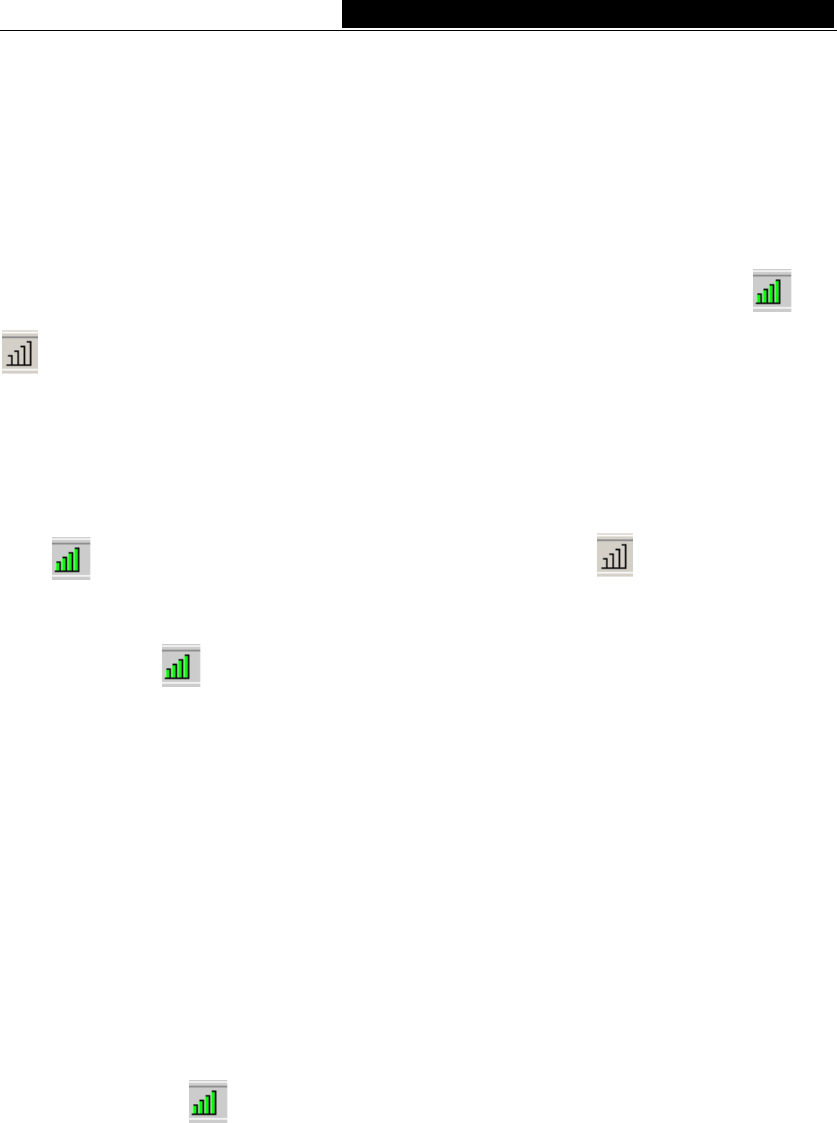
TL-WN321G 54M Wireless USB Adapter User Guide
Chapter 3: Configuration
TP-LINK TL-WN321G USB Wireless Adapter can be configured by its utility. This section
describes how to configure your USB Wireless Adapter for wireless connectivity on your
Wireless Local Area Network (WLAN) and use the data security encryption features.
After the Adapter's driver and utility has been installed, the adapter’s tray icon, or
, will appear in your system tray. It means the utility is running on your system. If the
utility does not run, you can run the utility by clicking: Start> Program> TP-LINK>
TL-WN321G WIRELESS UTILITY> TL-WN321G Wireless Utility. If the icon still does
not appear, the driver or utility may be installed incorrectly or the adapter is unplugged,
please try again.
Icon means the connection has been established. Icon means there is no
connection.
Double-click the icon and the configuration screen of the utility will appear. You can
also run the utility by clicking: Start> Program> TP-LINK> TL-WN321G WIRELESS
UTILITY> TL-WN321G Wireless Utility. The utility provides a complete and easy to use
set of tools to:
¾ Display current status information
¾ Edit and add configured profiles
¾ Display current diagnostics information
The section below introduces these above capabilities.
Note: If your OS is Windows XP, you can use Windows XP to configure the wireless
network settings. (To use this function, you must upgrade the OS with sp1).
If you want to use Windows XP to configure wireless network settings, just exit the utility.
Right-click the icon at the bottom of the screen, and click Exit to exit the utility.
3.1 Profile
Click the Profile tab of the utility and the Profile screen will appear, figure 3-1. The
Profile screen provides tools to:
¾ Add a Profile
¾ Delete a profile
¾ Edit a profile
¾ Activate a profile
- 7 -
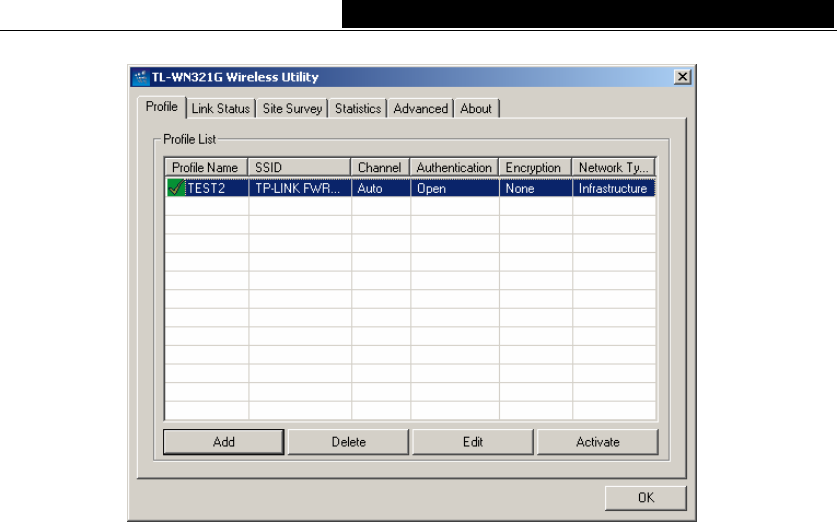
TL-WN321G 54M Wireless USB Adapter User Guide
Figure 3-1 Profile Tab
To create a new profile, click the Add button on the Profile tab, the Profile configuration
screen will appear as shown in figure 3-2.
To edit a profile, highlight the desired profile name on Profile Name list, and click the
Edit button, the Profile configuration screen will appear shown in figure 3-1.
To delete a profile, highlight the desired profile name on Profile Name list, and click the
Delete button.
To switch to another profile, highlight the desired profile name on Profile Name list,
and click the Activate button.
Note: Do not forget to click the Apply button when you create a new profile for
connection.
3.1.1 Add or Edit a Configuration Profile
To add a new configuration profile, click Add button on the Profile Management tab. To
modify a configuration profile, select the configuration from the Profile list and click Edit.
The Profile Management dialog box will display a screen similar to that shown in Figure
3-2.
1. Edit the Configuration tab
¾ Profile Name - Identifies the configuration profile. This name must be unique.
Profile names are not case-sensitive.
¾ SSID - The IEEE 802.11 wireless network name. This field has a maximum limit of
32 characters.
¾ PSW(Power Save Mode)
• CAM(Constantly Awake Mode) - Continuous Access Mode.
• PSW(Power Saving Mode) - Power Saving mode.
- 8 -
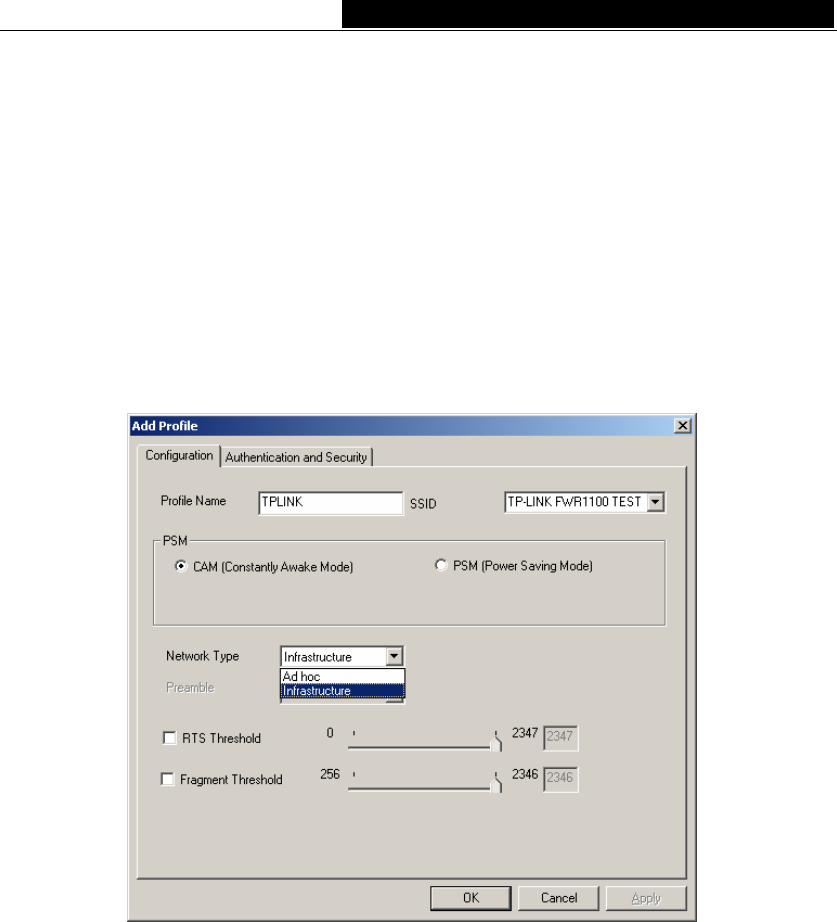
TL-WN321G 54M Wireless USB Adapter User Guide
¾ Network Type - Displays the wireless mode, either Ad-hoc or Infrastructure mode
¾ Preamble - Specifies the preamble setting in 802.11b. The default setting is Auto
Switch (access point mode), which allows both short and long headers in the
802.11b frames. The adapter can only use short radio headers if the access point
supports and uses them.
¾ RTS Threshold - Default is 2312.
¾ Fragment Threshold - Default is 2312.
¾ Ad-hoc mode - Displays the wireless mode, either Only 802.11B or 802.11B/G
mode.
¾ Channel - Shows the current channel in use. This field determines which operating
frequency will be used.
Figure 3-2 Add Profile - configuration
2. Edit the Authentication and Security tab
- 9 -
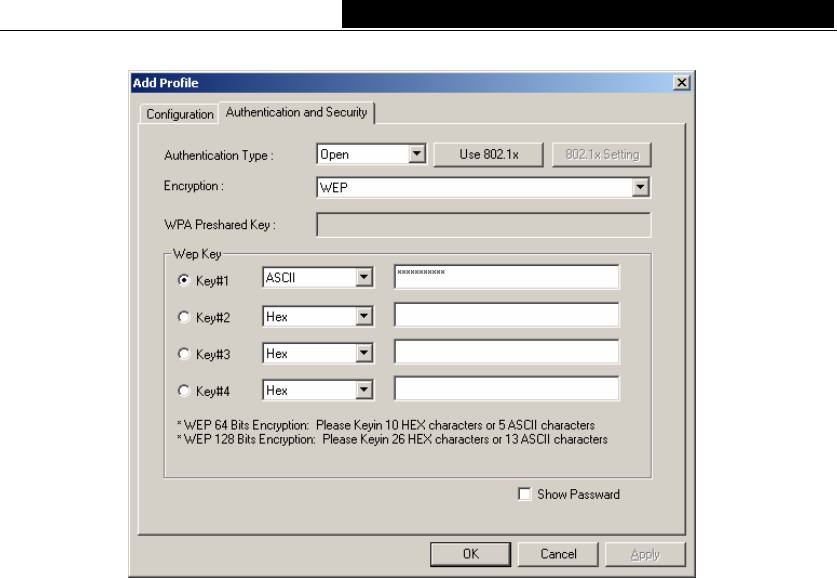
TL-WN321G 54M Wireless USB Adapter User Guide
Figure 3-3 Add Profile – configuration
¾ Authentication Type - Three options, Open System, Shared-Key System or
LEAP.
¾ 802.1x Setting - It enables when Authentication Type is setting to WPA.
¾ Encryption - Displays which encryption type that the driver is using. When you
select Open System, Shared-Key System as Network Authentication, there are
two options: WEP and Disabled. If you select WPA-PSK as Network
Authentication, there are TKIP and AES options instead of WEP and Disabled.
¾ Wep Key - Key #1, Key #2, Key #3, Key #4, the Key groups. You can enter 10
hexadecimal digits (any combination of 0-9, a-f, A-F) or 5 ASCII characters for 64-bit
(also called 40bits) encryption. You can enter 26 hexadecimal digits (any
combination of 0-9, a-f, A-F) or 13 ASCII characters for 128-bit (also called 104bits)
encryption.
3.2 Link Status
The Link Status tab displays the adapter's current status.
- 10 -
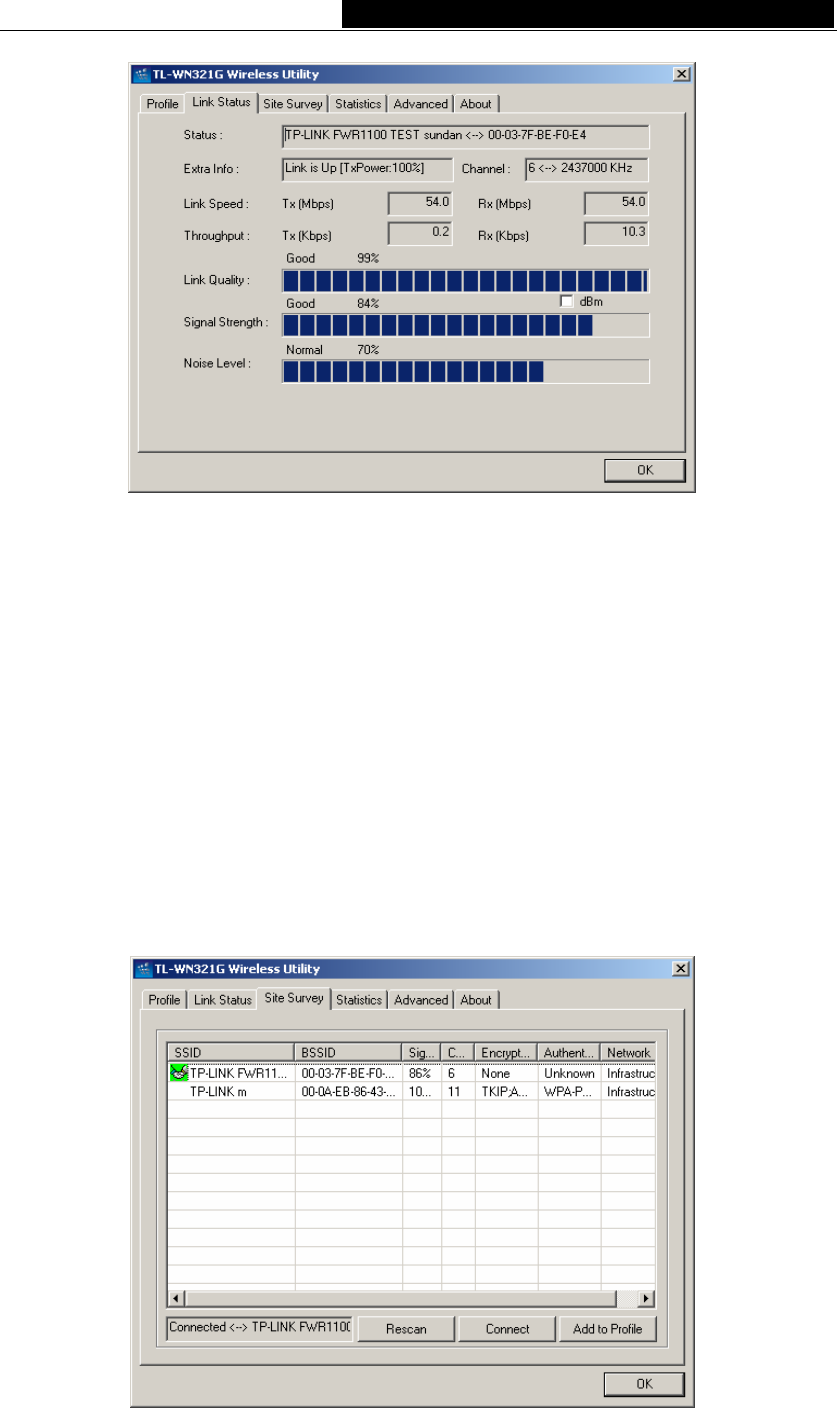
TL-WN321G 54M Wireless USB Adapter User Guide
Figure 3-4 Link Status
The following table describes the items found on the Network Status screen.
¾ Status - Shows whether the station is connected to the wireless network, if not
connected, display RF is closed; if connected, display AP name and BSSID.
¾ Extra Info - Shows link status and the current channel in use.
¾ Link Speed - Shows the current max Transfer rate, unit is Mbit/sec.
¾ Throughput - Displays Tx and Rx rate, unit is Kbits/sec.
¾ Link Quality - Shows the quality of the signal.
¾ Signal Strength - Shows the strength of the signal.
3.3 Site Survey
Click the Site Survey tab of the Utility and the Site Survey screen will appear, figure 3-5.
On the Site Survey screen you can scan the Available Infrastructure and Ad Hoc
Networks.
Figure 3-5 Site Survey tab
- 11 -
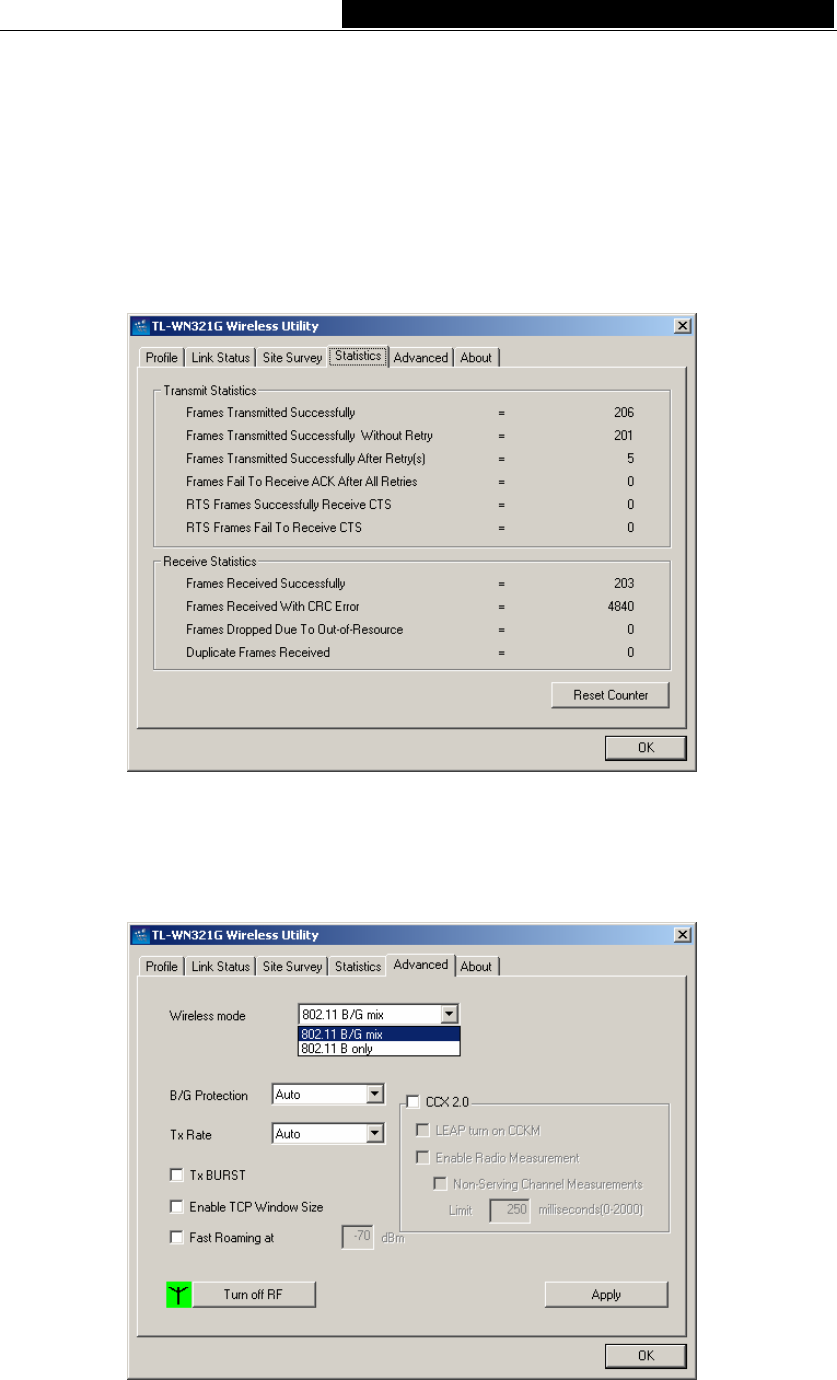
TL-WN321G 54M Wireless USB Adapter User Guide
Click the Rescan button to refresh the list at any time. Highlight an SSID and click the
Connect button to connect to an available network.
3.4 Statistics
The Statistics tab shows receiving and transmitting statistical information for the
following receive and transmit diagnostics for frames received by or transmitted to the
wireless network adapter. Click the Reset Counter button to reset the count of the
statistics information.
Figure 3-6 Statistics tab
3.5 Advanced
On this Screen, you can configure the WEP key or view the configured WEP key.
Figure 3-7 Advanced
- 12 -
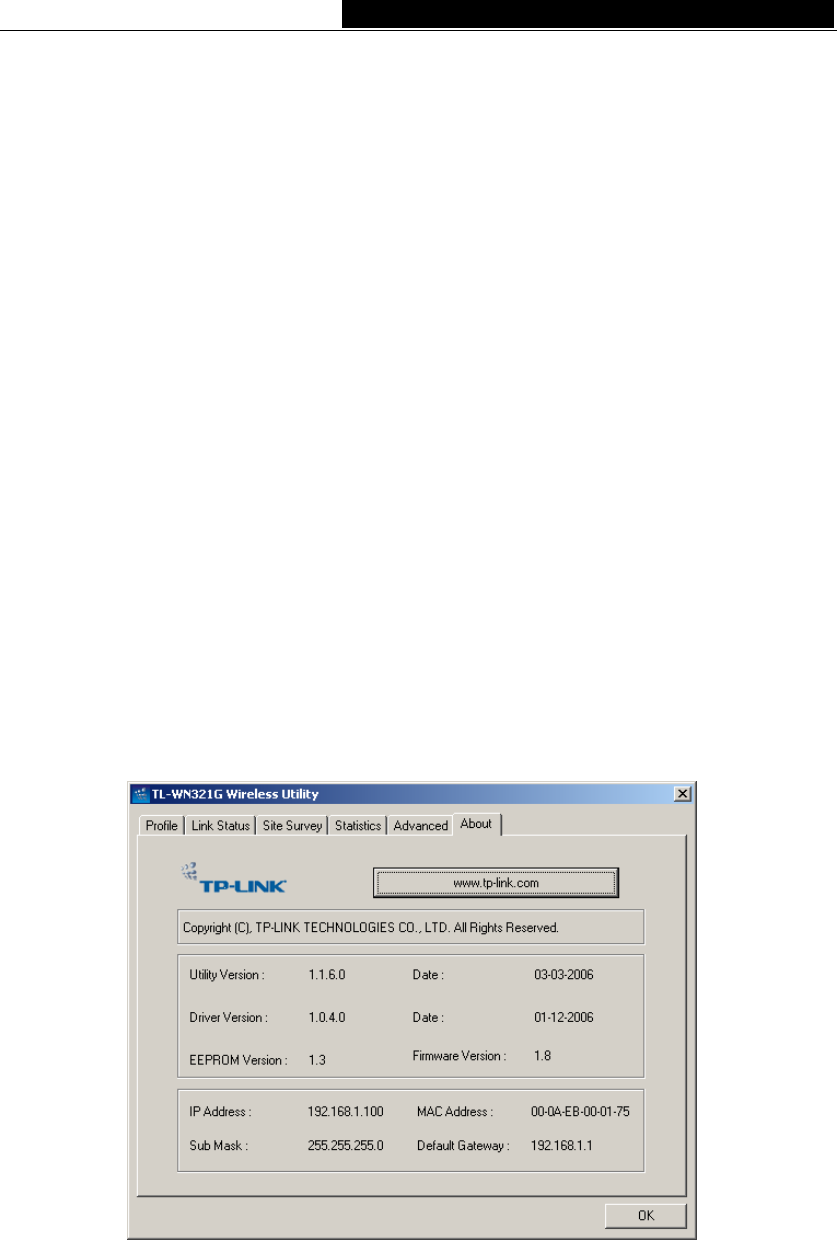
TL-WN321G 54M Wireless USB Adapter User Guide
¾ Wireless mode - Displays the wireless mode, either 802.11B/G mix or 802.11B
only.
¾ B/S Protection - There are three options: either Auto or Enable, or Close.
¾ TxRate - Shows the current Transfer rate.
¾ TxBURST - It can translate more data when it enable.
¾ Fast Roaming at - Roaming will disable when Transmit Power is below some dBm.
¾ Turn off RF - The wireless radio of this adapter can be enabled or disabled. You
can turn the wireless radio off by selecting the check-box.
¾ Apply - Click the Apply button to save the current setting.
3.6 About
This screen displays some information about this adapter, including Driver Date, Driver
Version, Utility Date, Utility Version, MAC Address, IP Address, SubMask, Power Save
mode and Preamble.
¾ Utility Version - The version of this utility.
¾ Utility Date - The creation date of this utility.
¾ Driver Version - The version of the wireless network adapter driver.
¾ Driver Date - The creation date of the wireless network adapter driver.
¾ EEPROM Version - The version of this EEPROM.
¾ IP Address - The IP address of the wireless network.
¾ Phy_Address - The MAC address of the wireless network adapter.
¾ SubMask - The subnet mask of the wireless network.
¾ Default Gateway - The default gateway of the wireless network.
Figure 3-8 About
3.7 An example for application
Suppose you have an installed and using AP, the SSID is TPLINK and it adopts 64-bit
encryption with the key 0123456789. To establish a connection with this AP, you should
follow these steps below:
- 13 -

TL-WN321G 54M Wireless USB Adapter User Guide
1. Launch TL-WN321G Wireless Utility.
2. Click the Profile tab of the utility and click the New button on the screen that
appears.
3. The Profile configuration screen will appear, please enter Test for the Profile Name,
TPLINK for the SSID, select Infrastructure for the Network Mode, select WEP for the
Data Encryption and enter 0123456789 for Network key.
4. Click OK to save this profile.
5. Click Apply on the Profile screen. The utility will establish a connection with this AP
by configured profile.
- 14 -

TL-WN321G 54M Wireless USB Adapter User Guide
Appendix A: Specifications
Normal
Interface A-type USB 2.0 Connector
Standards IEEE802.11b; IEEE802.11g
Operating System Windows 98Se, Me, 2000, XP
Transmission
Distance
In door up to 100m, out door up to 300m (it is limited to the
environment).
Radio Data Rate 54/48/36/24/18/12/9/6Mbps or 11/5.5/3/2/1Mbps
(Auto Rate Sensing)
Modulation 1M DBPSK; 2M DQPSK; 5.5M, 11M CCK; 6M, 9M, 12M, 18M,
24M, 36M, 48M, 54M OFDM;
Media Access
Protocol
CSMA/CA with ACK
Transmit Power 22dBm (Typical)
Data Security WPA; 64/128 BIT WEP; TKIP/AES; IEEE802.1x authentication
Frequency 2.4 ~ 2.4835GHz
Spread Spectrum Direct Sequence Spread Spectrum (DSSS)
Power
Consumption
Typically 480mA in full Transmit (TX), 420mA in full Receive (RX)
Safety & Emissions FCC, CE
Physical Environmental
Operating Temp 0℃~40℃ (32℉~104℉)
Storage Temp -40℃ – 70℃ (-40℉~158℉)
Humidity 10% - 95% RH, Non-condensing
Dimensions
(W×D×H)
3.4×1.0×0.5 in. (86×26×12 mm)
- 15 -

TL-WN321G 54M Wireless USB Adapter User Guide
Appendix B: Glossary
¾ 802.11b - The 802.11b standard specifies a wireless networking at 11 Mbps using
direct-sequence spread-spectrum (DSSS) technology and operating in the
unlicensed radio spectrum at 2.4GHz, and WEP encryption for security. 802.11b
networks are also referred to as Wi-Fi networks.
¾ 802.11g - specification for wireless networking at 54 Mbps using direct-sequence
spread-spectrum (DSSS) technology, using OFDM modulation and operating in the
unlicensed radio spectrum at 2.4GHz, and backward compatibility with IEEE 802.11b
devices, and WEP encryption for security.
¾ Ad-hoc Network - An ad-hoc network is a group of computers, each with a wireless
adapter, connected as an independent 802.11 wireless LAN. Ad-hoc wireless
computers operate on a peer-to-peer basis, communicating directly with each other
without the use of an access point. Ad-hoc mode is also referred to as an
Independent Basic Service Set (IBSS) or as peer-to-peer mode, and is useful at a
departmental scale or SOHO operation.
¾ DSSS (Direct-Sequence Spread Spectrum) - DSSS generates a redundant bit pattern
for all data transmitted. This bit pattern is called a chip (or chipping code). Even if one
or more bits in the chip are damaged during transmission, statistical techniques
embedded in the receiver can recover the original data without the need for
retransmission. To an unintended receiver, DSSS appears as low power wideband
noise and is rejected (ignored) by most narrowband receivers. However, to an
intended receiver (i.e. another wireless LAN endpoint), the DSSS signal is recognized
as the only valid signal, and interference is inherently rejected (ignored).
¾ FHSS (Frequency Hopping Spread Spectrum) - FHSS continuously changes (hops)
the carrier frequency of a conventional carrier several times per second according to
a pseudo-random set of channels. Because a fixed frequency is not used, and only
the transmitter and receiver know the hop patterns, interception of FHSS is extremely
difficult.
¾ Infrastructure Network - An infrastructure network is a group of computers or other
devices, each with a wireless adapter, connected as an 802.11 wireless LAN. In
infrastructure mode, the wireless devices communicate with each other and to a
wired network by first going through an access point. An infrastructure wireless
network connected to a wired network is referred to as a Basic Service Set (BSS). A
set of two or more BSS in a single network is referred to as an Extended Service Set
(ESS). Infrastructure mode is useful at a corporation scale, or when it is necessary to
connect the wired and wireless networks.
¾ Spread Spectrum - Spread Spectrum technology is a wideband radio frequency
technique developed by the military for use in reliable, secure, mission-critical
communications systems. It is designed to trade off bandwidth efficiency for reliability,
- 16 -

TL-WN321G 54M Wireless USB Adapter User Guide
integrity, and security. In other words, more bandwidth is consumed than in the case
of narrowband transmission, but the trade off produces a signal that is, in effect,
louder and thus easier to detect, provided that the receiver knows the parameters of
the spread-spectrum signal being broadcast. If a receiver is not tuned to the right
frequency, a spread-spectrum signal looks like background noise. There are two
main alternatives, Direct Sequence Spread Spectrum (DSSS) and Frequency
Hopping Spread Spectrum (FHSS).
¾ SSID - A Service Set Identification is a thirty-two character (maximum) alphanumeric
key identifying a wireless local area network. For the wireless devices in a network to
communicate with each other, all devices must be configured with the same SSID.
This is typically the configuration parameter for a wireless PC card. It corresponds to
the ESSID in the wireless Access Point and to the wireless network name.
¾ WEP (Wired Equivalent Privacy) - A data privacy mechanism based on a 64-bit or
128-bit or 152-bit shared key algorithm, as described in the IEEE 802.11 standard.
¾ Wi-Fi - A trade name for the 802.11b wireless networking standard, given by the
Wireless Ethernet Compatibility Alliance (WECA, see http://www.wi-fi.net), an
industry standards group promoting interoperability among 802.11b devices.
¾ WLAN (Wireless Local Area Network) - A group of computers and associated
devices communicate with each other wirelessly, which network serving users are
limited in a local area.
¾ WPA (Wi-Fi Protected Access) - A wireless security protocol use TKIP (Temporal
Key Integrity Protocol) encryption, which can be used in conjunction with a RADIUS
server.
- 17 -
